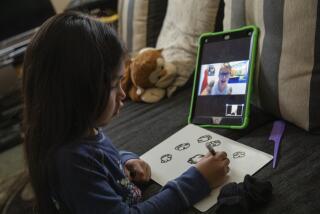Web Offers Few Riches for Poor
- Share via
WASHINGTON — The digital divide may be narrowing between haves and have-nots in terms of access, but experts say the gap in content is enormous.
A study released Wednesday found that at least 50 million Americans are poorly served by the Internet because of a dearth of Web sites targeting the needs of people with low incomes and those who don’t read or speak English well.
Conducted by the Children’s Partnership, a nonprofit group based in Santa Monica, the report found limited information about jobs, housing or the educational needs of low-income Americans.
The report, entitled “Online Content for Low-Income and Underserved Americans: The Digital Divide’s New Frontier,” suggested that Internet content providers use more sophisticated search, translation and multimedia tools, such as the audio presentation of text material, to make existing online content more accessible.
They also suggested that content providers hire people in low-income and immigrant neighborhoods to create Web sites that are more appealing and relevant to those audiences.
“There’s been so much focus on the boxes and wires to connect to the Internet that we almost forgot to ask what people are getting once they connect,” said Wendy Lazarus, coauthor of the study and founder of the Children’s Partnership.
“We found a strong desire among people for practical, local information about their neighborhoods that seems to fly in the face of the way the Internet is moving in terms of national portals” like Yahoo, Netscape and Excite, Lazarus said. She noted that the 50 million underserved Americans possess more than $300 billion in purchasing power.
The report comes as Silicon Valley’s growing ranks of multimillionaires have begun eyeing ambitious projects that might address the content gap.
Several high-tech executives and philanthropic foundations have announced projects aimed at making the Internet more appealing and useful for low-income users, who are increasingly gaining access to the global computer network through public schools, community centers and falling computer prices.
The New York-based Markle Foundation announced Wednesday, for instance, that it would spend $1 million to develop online content targeting low-income Americans. That announcement came a day after Internet software billionaire Michael Saylor pledged to donate $100 million to launch a free online university that could reach hundreds of millions of people worldwide.
Mario Morino, a Reston, Va., a philanthropist who heads his own technology think tank, the Morino Institute, says the flood of money, though well-meaning, could potentially do more harm than good if government and industry don’t first work with neighborhoods to build the skills needed to utilize new technology.
“I think we have to [first] strengthen neighborhoods and revitalize families,” Morino said. “Many of these communities don’t have the organizational structure . . . to effectively use this technology.”
The 47-page study examined 1,000 Web sites and found that only 6% contained the kind of local information that people at or below the federal poverty line said they wanted.
Low-income Americans said they wanted more information on local housing, local jobs and more culturally diverse and multilingual content. But about 87% of Web pages are in English, while 32 million Americans speak a different primary language. Similarly, the overwhelming majority of Web content is in text and graphics rather than easier-to-understand, but bandwidth-consuming, sound and video.
Still, the study turned up several innovative Web sites that are attempting to address these concerns about Web content.
The Social Security Administration’s Web pages were cited by Children’s Partnership as examples of practical Web information presented in highly accessible formats. But for the most part, it was community organizations, schools and even businesses--not governments--that provided the most frequent examples of engaging Web content targeted at citizens with low incomes and limited English-language skills.
When it came to immigration information, for example, the survey cited not the Immigration and Naturalization Service, but the commercial Immigration-USA.com as a Web site “containing vital information for immigrants.” The site provides information in five different languages and includes a comprehensive list of immigration forms.
And Prairienet, part of the Community Networking Initiative at the University of Illinois, was cited for training more than 500 low-income residents in computer skills and for maintaining Web pages on everything from child-care resources to neighborhood help resource guides to health care services and jobs.
(BEGIN TEXT OF INFOBOX / INFOGRAPHIC)
Who’s on the Net
Although more people are gaining access to the Internet, significant gaps remain in the areas of income, education and race. Listed below are the percentage of Internet users by various groupings:
*
Sources: U.S. Dept. of Commerce, “Falling Through the Net: Defining the Digital Divide,” July 1999; The Children’s Partnership
Researched by NONA YATES/Los Angeles Times






